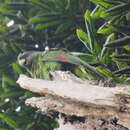Biology
(
الإنجليزية
)
المقدمة من Arkive
The highly social red-necked Amazon flocks in groups of 30 or more during the non-breeding season, but becomes highly territorial during the nesting season. Breeding occurs from January to June, with fledging from May through to August - sometimes later still (2) (7). Nests are made in deep cavities formed in rainforest trees, with pairs showing high nest site fidelity, often occupying the same nest cavity for many years. Although the female produces a clutch of three eggs, which she incubates for about 26 to 28 days, breeding pairs usually successfully fledge only two chicks per year (2). Both the male and female are actively involved in care and feeding of the young from hatching to well past fledging. Their larger clutch size than other large island Amazons, combined with both parents investing in rearing, is thought to help explain how the red-necked Amazon has rebounded so quickly following the population crash it experienced as a result of the 1979 and 1980 hurricanes (9).
Another factor thought to have helped this particular Amazon species recover is its adaptation to exploiting the readily accessible cultivated citrus fruits, supplementing its natural diet of fruits, flowers, shoots and seeds of more than 30 species of rainforest trees and plants (2) (9). Unfortunately, this practice is also likely to establish the bird as an enemy of farmers within its range (6).
Conservation
(
الإنجليزية
)
المقدمة من Arkive
The red-necked Amazon is fully protected under domestic legislation, and the formation of the Northern Forest Reserve, Morne Diablotin National Park, Central Forest Reserve, and Morne Trois Pitons National Park have been essential in supplying protected habitat for the parrots (4). Since 2001, a Public Service Announcement Program has been run as a collaborative effort between Dominica's Forestry, Wildlife, and Parks Division and the Rare Species Conservatory Foundation (RSCF), effectively delivering targeted environmental and conservation education messages to the public. A group of captive parrots are held at the Parrot Conservation and Research Centre in Dominica, but no reintroductions to the wild are currently planned (2).
Description
(
الإنجليزية
)
المقدمة من Arkive
This colourful parrot is named for the conspicuous reddish-orange patch on its lower throat, which stands out against the primarily deep green plumage of the body. By contrast, the face and forecrown are blue-violet, set off by a bright orange iris (2). In flight, a scarlet wing patch and yellow-green rump and tail tip are clearly visible (4). The beak and feet are pale grey (2).
Habitat
(
الإنجليزية
)
المقدمة من Arkive
Found mainly in the canopy of rainforests, chiefly between 300 and 800 metres above sea level, but occasionally to 1,200 metres (5) (8). Formerly a regular visitor to coastal areas, the red-necked Amazon still descends to low elevations in October to December in search of food, and sometimes ranges into more open, cultivated land (mainly citrus crops) (5) (8).
Range
(
الإنجليزية
)
المقدمة من Arkive
The red-necked Amazon is endemic to the Caribbean island of Dominica, West Indies, where it is now distributed island-wide, from the coast northeast of Morne Diablotin through the Central Forest Reserve and widely across the Morne Trois Pitons National Park in the south (5) (6) (7).
Status
(
الإنجليزية
)
المقدمة من Arkive
Classified as Vulnerable (VU) on the IUCN Red List (1), and listed on Appendix I of CITES (3).
Threats
(
الإنجليزية
)
المقدمة من Arkive
Red-necked Amazon populations have been declining through the 20th Century, initially as a result of hunting for food and, to a lesser extent, the pet trade, and, more recently, by forest clearance for agriculture and the devastation of Hurricanes David (1979) and Allen (1980) (4). Fortunately, hunting and illegal trade no longer pose a serious threat, and this resilient bird has made a remarkable recovery, both in range expansion and overall population size, after it was decimated to an all time low of as few as 150 individuals in 1980 after the hurricanes. Although significant conservation action has helped this species to rebound to a far healthier 750 to 800 birds estimated to exist in 2003, another hurricane of the magnitude of Hurricane David could reverse recent population increases, and its small numbers and restricted range renders the red-necked Amazon far from secure (5).

